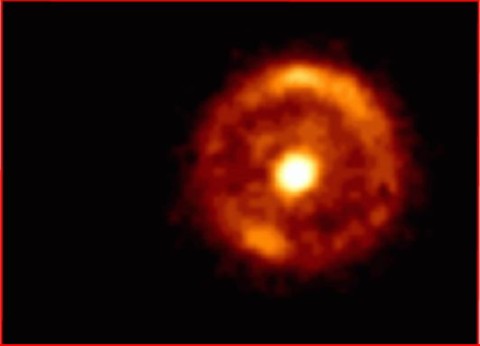
home •
about •
essential guide •
picture of the day •
thunderblogs •
news •
multimedia •
predictions •
products •
get involved •
contact

Credit: NICMOS, HST, NASA
pic of the day
archive
subject index
abstract
archive
Links:
Society for
Interdisciplinary
Studies
Aug 16, 2005
Gravitational Lensing Misused Again*
Conventional “gravity-only” astronomy sees in this image of a galaxy with a ring around it the bending of light by gravity: “Here the foreground galaxy acts like a huge gravitational lens, pulling the light from the background object ... into a nearly perfect giant ring around the foreground galaxy.”
But the father of conventional “gravity-only” astronomy, Albert Einstein, wouldn’t have agreed. In 1936 he published a one-page paper in Science on gravitational lensing. He said: Observe a certain star A on the sky and imagine another star B in the line of sight toward A. What will happen to the light coming from A? He showed that when A, B and the observer are exactly aligned a ring-like image will be formed. When B is even a small distance away from the line of sight, two images of A will be created. However, the angular separation between these images, or the diameter of the ring, is of the order of thousandths of an arc-second and cannot be resolved. What will be seen is only the enhanced brightness of A since the sum of the luminosity of the two images (or ring) is larger than the luminosity of the star itself.
The ring in this image, at one arc-second diameter, seems far too large to be a lensing effect. More plausibly this image shows all of the features of the "planetary nebula effect" viewed end-on. The electrical discharge nature of planetary nebulae was argued by Dr. Charles Bruce, FRAS, more than 50 years ago. It is a simple plasma phenomenon that is scalable from the laboratory to galactic proportions.
Plasma astronomers note that the ring is composed of bright spots that seem to be roughly paired and associated with filamentary "spokes" that have the so-called "foreground" galaxy as their hub. This is the typical appearance of a "plasma focus" discharge viewed along the axis. Furthermore, such discharges usually begin with 56 filaments and evolve into 28. Although it's difficult to count the spots in this ring, there could very well be 28.
Contributed by Don Scott
* This Picture of the Day was modified on Aug 17, 2005 to clarify the reasoning.
EXECUTIVE EDITORS:
David Talbott, Wallace Thornhill
MANAGING EDITOR:
Mel Acheson
CONTRIBUTING EDITORS: Michael Armstrong, Dwardu Cardona, Ev Cochrane,
C.J. Ransom, Don Scott, Rens van der Sluijs, Ian Tresman
WEBMASTER: Michael Armstrong
Copyright 2005: thunderbolts.info